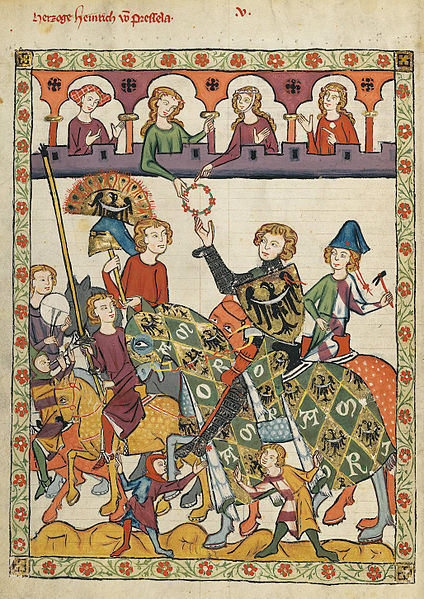During the Middle Ages, tournaments often contained a mêlée consisting of knights fighting one another on foot or while mounted, either divided into two sides or fighting as a free-for-all. The object was to capture opposing knights so that they could be ransomed, and this could be a very profitable business for such skilled knights as William Marshal. There was a tournament ground covering several square miles in northern France to which knights came from all over Europe to prove themselves in quite real combat. This was, in fact, the original form of tournaments and the most popular between the twelfth and thirteenth centuries—jousting being a later development, and one that did not completely displace the mêlée until many more centuries had passed. The original mêlée was engaged with normal weapons and fraught with as much danger as a normal battle. Rules slowly tempered the danger, but at all times the mêlée was more dangerous than the joust.
The provenance of the heavily armoured, aristocratic equestrian warrior has excited much debate. It has been argued, most notably by Lynn White, that it was the arrival of the stirrup in eighth-century Western Europe that prompted the emergence of cavalry capable of ‘mounted shock combat’. with lance held tightly ‘couched’ under the right arm; and that, moreover, since warhorses, armour, weapons, and military training required landed endowment for their maintenance, it was in effect the stirrup which was responsible for the establishment of a feudal aristocracy of equestrian warriors. More recent research, by Bernard Bachrach among others, has suggested that the solid fighting platform necessary for a rider to engage in mounted shock combat depended upon a combination of stirrup, wraparound saddle with rigid cantle (back plate), and double girthing or breast-collars. With the rider thus ‘locked onto the horse’s back in a sort of cock-pit’, it was possible, experimentally from the later eleventh century, and with greater regularity in the twelfth, to level a couched lance with the assurance of the combined weight of horse and rider behind it. Furthermore, historians no longer accept that the medieval aristocratic elite was actually brought into being by advances in horse-related technology. Rather, an existing military aristocracy-great lords and the household knights whom they armed and horsed-adopted new equipment when it became available, and pursued the tactical possibilities which that equipment offered. Those possibilities could not ensure battlefield supremacy for the knightly warrior. Nor was he the only important component in field armies. But the elite distinction of mounted shock combat, associated as it was with the emergence of chivalry as an aristocratic code of martial conventions and behaviour, gave rise to an image of the nobleman as equestrian warrior which, while being firmly grounded in reality, proved irresistible to manuscript illuminators and authors of romance literature, Although presenting an idealized world, such artistic works reflected the martial mentalite of the nobleman while contributing to its further elaboration and dissemination; and they leave us in no doubt that the warhorse was at the heart of the medieval aristocrat’s lifestyle and mental world.
This was perhaps most clearly displayed on the tournament field. It is surely significant that tournaments begin to appear in the sources in the early twelfth century. Apparently connected with the emergence of the new cavalry tactics, the tourney provided a training ground for individual skills with lance and sword, and team maneuvers by controls of knights. They also offered opportunities for reputations in arms to be made or enhanced, although that depended upon the identification of individuals amidst the dust and confusion of the mêlée. It was probably this need for recognition on the tournament field, as well as the similar demands of the battlefield, which brought about the development of heraldry in the twelfth century. Along with lance pennons, surcoats, and smooth shields, the caparisoned warhorse was emblazoned with heraldic devices, thereby becoming a perfect vehicle for the expression of individual identity and family honour within the military elite. A similar message was conveyed by the martial equestrian figures which, until the fourteenth century, were so commonly to be found on aristocratic seals, and by the ceremonial involvement of warhorses, decked out in heraldic caparisons, in the funerals of later medieval noblemen.
